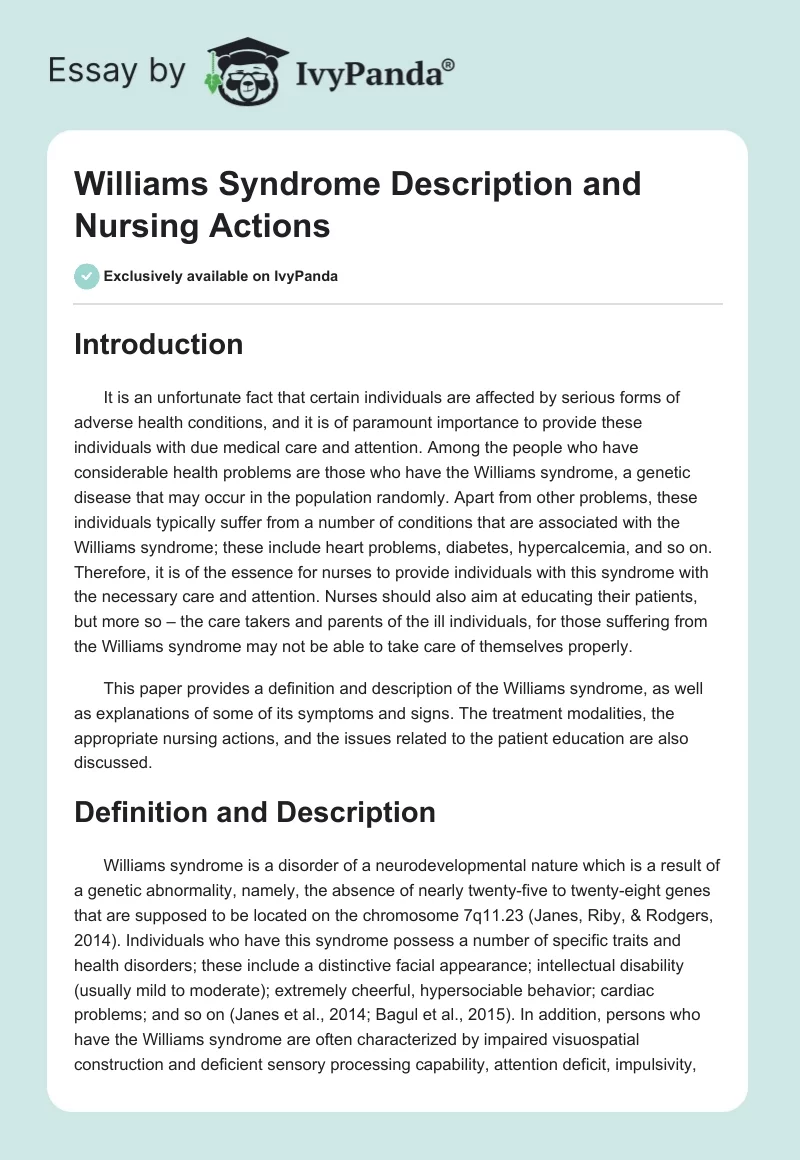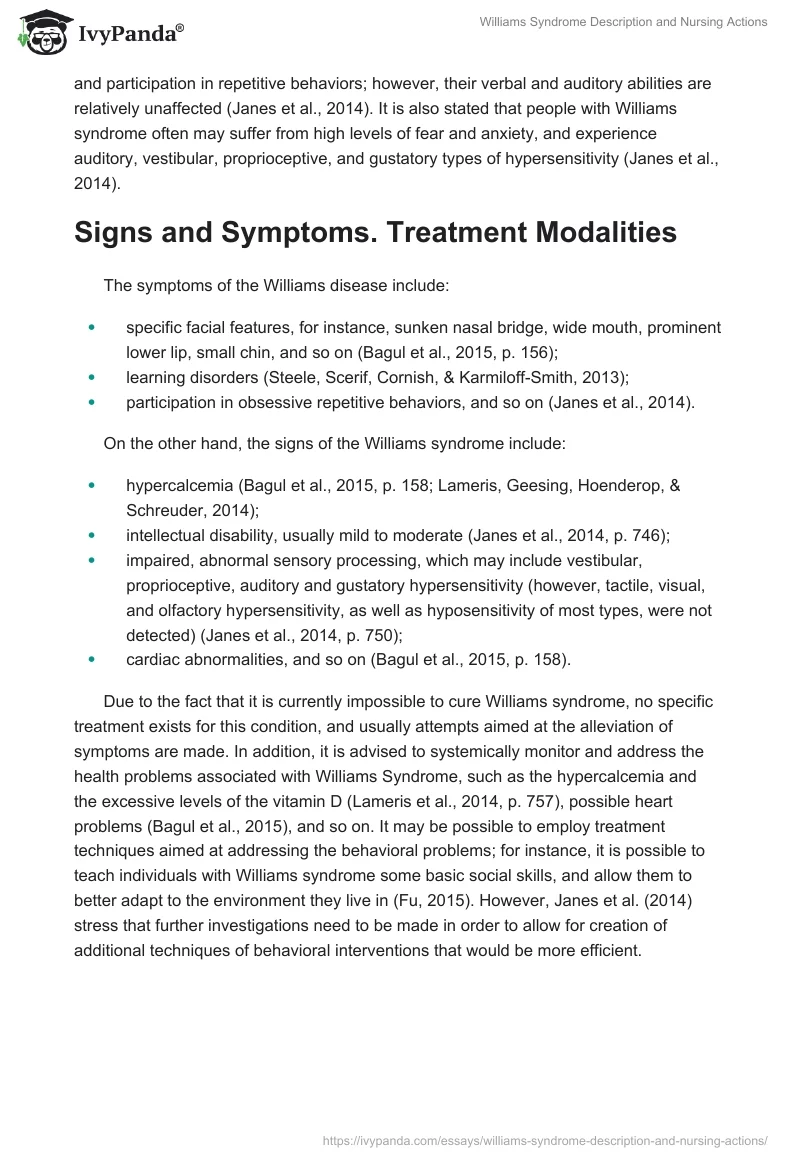Introduction
It is an unfortunate fact that some individuals are affected by severe forms of adverse health conditions, and it is vital to provide these individuals with due medical care and attention. Among the people who have considerable health problems are those who have Williams syndrome, a genetic disease that may occur in the population randomly.
Apart from other problems, these individuals typically suffer from a number of conditions that are associated with the Williams syndrome; these include heart problems, diabetes, hypercalcemia, and so on. Therefore, it is of the essence for nurses to provide individuals with this syndrome with the necessary care and attention.
Nurses should also aim at educating their patients, but more so – the care takers and parents of the ill individuals, for those suffering from the Williams syndrome may not be able to take care of themselves properly. This paper provides a definition and description of the Williams syndrome, as well as explanations of some of its symptoms and signs. The treatment modalities, the appropriate nursing actions, and the issues related to the patient education are also discussed.
Definition and Description
Williams syndrome is a disorder of a neurodevelopmental nature which is a result of a genetic abnormality, namely, the absence of nearly twenty-five to twenty-eight genes that are supposed to be located on the chromosome 7q11.23 (Janes, Riby, & Rodgers, 2014). Individuals who have this syndrome possess a number of specific traits and health disorders; these include a distinctive facial appearance; intellectual disability (usually mild to moderate); extremely cheerful, hypersociable behavior; cardiac problems; and so on (Janes et al., 2014; Bagul et al., 2015).
In addition, persons who have the Williams syndrome are often characterized by impaired visuospatial construction and deficient sensory processing capability, attention deficit, impulsivity, and participation in repetitive behaviors; however, their verbal and auditory abilities are relatively unaffected (Janes et al., 2014). It is also stated that people with Williams syndrome often may suffer from high levels of fear and anxiety, and experience auditory, vestibular, proprioceptive, and gustatory types of hypersensitivity (Janes et al., 2014).
Signs and Symptoms. Treatment Modalities
The symptoms of the Williams disease include:
- specific facial features, for instance, sunken nasal bridge, wide mouth, prominent lower lip, small chin, and so on (Bagul et al., 2015, p. 156);
- learning disorders (Steele, Scerif, Cornish, & Karmiloff-Smith, 2013);
- participation in obsessive repetitive behaviors, and so on (Janes et al., 2014).
On the other hand, the signs of the Williams syndrome include:
- hypercalcemia (Bagul et al., 2015, p. 158; Lameris, Geesing, Hoenderop, & Schreuder, 2014);
- intellectual disability, usually mild to moderate (Janes et al., 2014, p. 746);
- impaired, abnormal sensory processing, which may include vestibular, proprioceptive, auditory and gustatory hypersensitivity (however, tactile, visual, and olfactory hypersensitivity, as well as hyposensitivity of most types, were not detected) (Janes et al., 2014, p. 750);
- cardiac abnormalities, and so on (Bagul et al., 2015, p. 158).
Due to the fact that it is currently impossible to cure Williams syndrome, no specific treatment exists for this condition, and usually attempts aimed at the alleviation of symptoms are made. In addition, it is advised to systemically monitor and address the health problems associated with Williams Syndrome, such as the hypercalcemia and the excessive levels of the vitamin D (Lameris et al., 2014, p. 757), possible heart problems (Bagul et al., 2015), and so on.
It may be possible to employ treatment techniques aimed at addressing the behavioral problems; for instance, it is possible to teach individuals with Williams syndrome some basic social skills, and allow them to better adapt to the environment they live in (Fu, 2015). However, Janes et al. (2014) stress that further investigations need to be made in order to allow for creation of additional techniques of behavioral interventions that would be more efficient.
Appropriate Nursing Actions
Because a treatment for the Williams syndrome does not exist today, it might be recommended for nurses to provide care and attention to people diagnosed with this disorder by addressing their needs and, importantly, constantly monitoring the health of the patients in order to make sure that the numerous diseases and adverse health conditions which are associated with Williams syndrome do not emerge or are kept under medical control. A nurse, therefore, should pay attention to the blood pressure, sugar levels, the level of calcium in the blood, and so on.
In addition, a nurse may attempt to implement certain behavioral interventions which are believed to be potentially efficacious for individuals with Williams syndrome. For instance, it is possible for a nurse to attempt teaching a child with Williams syndrome a number of basic social skills (Fu, 2015). A nurse should also keep in mind that the children with Williams syndrome usually behave in an extremely cheerful manner even when there is a problem that needs addressing (Janes et al., 2014).
Patient Education to be Provided
It is apparent that due to the fact that the individuals with the Williams syndrome usually have a mild to moderate intellectual disability, and, in particular, are often incapable of full-fledged abstract thinking (Janes et al., 2014), it might be problematic to supply them with patient education. Therefore, the education that nurses provide often should be given to the relatives of an individual with Williams syndrome or other persons who take care of these people.
The education supplied by nurses should be aimed at the elaboration of the common adverse health conditions that the individuals with the Williams syndrome are commonly affected by (for instance, heart problems), as well as at explaining the ways of their monitoring and management. In addition, it is paramount that nurses supply parents or other care takers with information pertaining to the specific educational and attitudinal needs of children with the Williams syndrome.
For instance, the care takers ought to be aware of the fact that the individuals with Williams syndrome often suffer from depression and anxiety, and that it is important to help them to manage these problems; they should also know that certain activities or phenomena, such as music, seem to have a considerable positive influence on their mood, which could potentially allow for the alleviation of stress that these persons often experience.
Caretakers, therefore, should know ways which can be used in order to address the behavioral, anxiety, impulsivity and other issues (Janes et al., 2014; Fu, 2015). They should also be aware of the hypersensitivity issues (abnormal sensory processing) which were detected among the children with Williams syndrome in the study that was carried out by Janes et al. (2014).
Evidence-Based Practice or Statistical Information
In their article, Janes et al. (2014) do not provide any information related to the use of nursing evidence-based practice in order to address the issues pertaining to the Williams syndrome. The important number provided by the authors assesses the frequency of the Williams syndrome in the population; it is stated that the Williams syndrome occurs, on the average, in one per 20,000 babies who are born (Janes et al., 2014, p. 746).
References
Bagul, P. K., Borgaonkar, D. V., Jaiswal, V., Phadke, M. S., Lanjewar, C. P., & Kerkar, P. G. (2015). Myriad manifestations of Williams syndrome. Indian Heart Journal, 67(2), 156-158. Web.
Fu, T. J. (2015). Profiles and development of adaptive behavior in adolescents and adults with Williams syndrome. International Journal of Information and Education Technology, 5(12), 931-935.
Janes, E., Riby, D. M., & Rodgers, J. (2014). Exploring the prevalence and phenomenology of repetitive behaviours and abnormal sensory processing in children with Williams Syndrome. Journal of Intellectual Disability Research, 58(8), 746-757. Web.
Lameris, A. L. L., Geesing, C. L. M., Hoenderop, J. G. J., & Schreuder, M. F. (2014). Importance of dietary calcium and vitamin D in the treatment of hypercalcaemia in Williams-Beuren syndrome. Journal of Pediatric Endocrinology & Metabolism, 27(7-8), 757-761. Web.
Steele, A., Scerif, G., Cornish, K., & Karmiloff-Smith, A. (2013). Learning to read in Williams syndrome and Down syndrome: Syndrome-specific precursors and developmental trajectories. Journal of Child Psychology & Psychiatry, 54(7), 754-762. Web.


